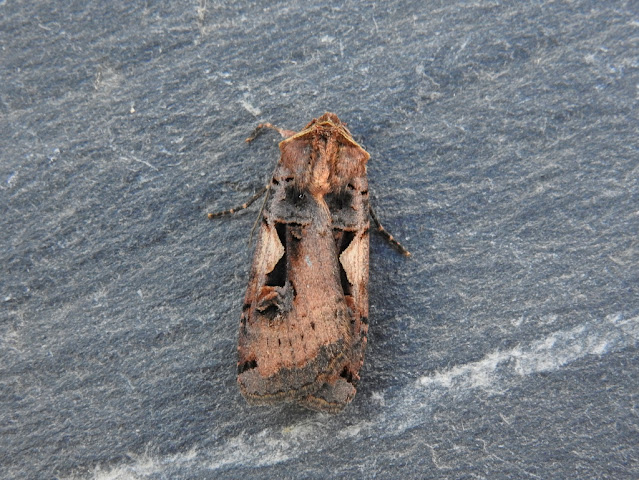I can think of at least a couple of times that Twitter has familiarised me with a moth sufficiently well prior to a real-life encounter that I have recognised it instantly when the time came. And so it was with this morning's new one.
Listed as 'Nationally Scarce B', Scrobipalpa ocellatella (the Beet Moth) is described thus on UK Moths:
'A rather local species, occurring on shingle coasts and saltmarshes along the southern coast of England and Wales.'
Norfolk had its first record in 2019, and by the end of 2021 there had still been less than 10 records in that county. However, this year something profound has happened. Less than a week ago, one Norfolk moth-er had 209 in his trap! As well as many records from inland counties like Wiltshire, in recent days Scrobipalpa ocellatella has reached Derbyshire and Yorkshire for the first time. Dorset-wise there are but a handful of dots on Living Record currently, but I am pretty sure this is about to change...
As I went through this morning's egg trays I spied what I thought was going to be Blastobasis adustella, a common micro. But a closer look had me reaching urgently for a pot. This was dead ringer for the countless ocellatella photos on my Twitter feed. Just as I was closing in for the capture it whizzed across the garage, disappearing into a stack of clutter. And that was that. A few minutes later I spotted another micro bouncing around the inner wall of the trap, just inches from freedom, but this time somehow potted it. And Scrobipalpa ocellatella was mine.*

|
|
Just 7mm, and admittedly not a looker. Behaved badly in the studio too, and this was the best of the very few shots I managed before it
flew. |
Some other nice moths today...

|
|
A rather pretty version of the highly variable
Common Marbled Carpet. |

|
|
Setaceous Hebrew Character is a regular, but this fresh example
definitely deserved a photo. |

|
|
The very lovely Green Carpet. Again, quite common. |
The three moths above are perched upon a slab of stone that I found in the forbidden field at Cogden today. I thought it was slate, but the pale marbling has me doubting that now. Anyway, whatever it is, I thought it might be okay for moth pics, so brought it home and gave it a scrub up. Anyway...
As well as lumps of stone, there were also a few birds at Cogden. Not loads, but enough to make you think there might be something better around the corner. There wasn't.
The most unexpected bird was this one...

|
|
This Red Kite showed really well, but I made a hash of most of
the photos. |
Other than that it was all about routine common migrants. A lot of scratching
about for 5 Spotted Flycatchers, 8 Wheatears, 10
Whinchats and a single Redstart. As is so often the case, birds
were mostly in discrete clusters. Two groups of 4 Whinchats apiece, 4
Spot Flys together and 5 Wheatears in one field. I didn't walk
the beach, so probably missed a number of Wheatears there.

|
| Whinchat |

|
|
Whinchat again |

|
|
Spotted Flycatcher |
In between these little pockets of action, very little. But I didn't care. I
mean, how could I? If you're going to do some birding that involves scattered
little groups of routine common migrants with big gaps of nothing in between,
there aren't many lovelier places you could pick...

|
|
Cogden. Beautiful. |
* Yes, mothing does weird things to you.
Welcome to the Beet Moth Club 👍They have also reached Worcestershire in numbers this year, mostly in other people's gardens. However, two were considerate enough to land in my trap on two separate nights this month 🙂
ReplyDeleteIt's all kicked off here now. At least 35 trapped last night!
DeleteI'd best try a bit harder then!
ReplyDelete